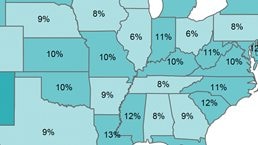The United States could add up to $4.3 trillion in annual GDP in 2025 if women attain full gender equality. In a new report, The power of parity: Advancing women’s equality in the United States, the McKinsey Global Institute (MGI) finds that every US state and city can add at least 5 percent to their GDP in that period by advancing the economic potential of women. Half of US states have the potential to add more than 10 percent, and the country’s 50 largest cities can increase GDP by 6 to 13 percent.
While the barriers hindering women from fully participating in the labor market make it unlikely that they will attain full gender equality within a decade, the report finds that in a best-in-class scenario—in which each US state matches the state with the fastest rate of improvement toward gender parity in work over the past decade—some $2.1 trillion of incremental GDP could be added in 2025. That is 10 percent higher than in a business-as-usual scenario.


Visualizing gender inequality
MGI's data visualization explores aspects of the gender gap in the United States and sizes the economic opportunity from closing it.
Achieving this potential would require about $475 billion more capital investment in 2025 to help create the 6.4 million jobs needed to secure that boost to GDP and improve productivity. About 40 percent of the potential can come from higher female labor-force participation, about 30 percent can come from narrowing the gap between men and women who work part time and full time, and another 30 percent can come from changing the mix of sectors in which women work to increase employment in more productive ones.
Worldwide, enhancing women’s economic potential has gone hand in hand with achieving greater social gender equality. For this reason, MGI has taken a broad view of gender inequality in the United States, using ten indicators of gender equality in work and society. US gender inequality is low or medium on four: labor-force participation rate, professional and technical jobs, higher education, and maternal mortality. Inequality is high or extremely high on six: leadership and managerial positions, unpaid care work, single mothers, teenage pregnancy, political representation, and violence against women. These six should be prioritized as “impact zones” for action. To give an idea of the considerable challenges that the United States faces, there are just 66 women for every 100 men in business-leadership and managerial positions, women do almost double the unpaid care work that men do, and there is one incident of sexual violence for every two women in the United States.
The ten indicators were used to develop a state parity score that indicates the distance from gender parity in all 50 US states. State parity scores range from 0.58 to 0.74 (on a scale of 0 to 1, where 1 indicates parity), indicating that all states have considerable distance to travel to achieve gender equality. In four of the six impact zones, ten states account for more than half of the women affected.
MGI also developed a city parity score for 50 metropolitan statistical areas, or cities. Cities vary in their performance on the eight indicators, but all have an opportunity improve on gender equality.
Action by individual organizations and collaboration among them are both required to accelerate change. Businesses can promote gender diversity in their own organizations in areas such as recruitment and performance evaluation. Governments can consider ways to make paid parental leave and improved child care a reality for more men and women and can introduce state-level programs to address issues like teenage pregnancy. More cross-sector collaboration between governments, businesses, and nonprofit organizations is needed. More work is required to collect robust and consistent data on gender inequality to inform discussion about which interventions are likely to be most effective.

